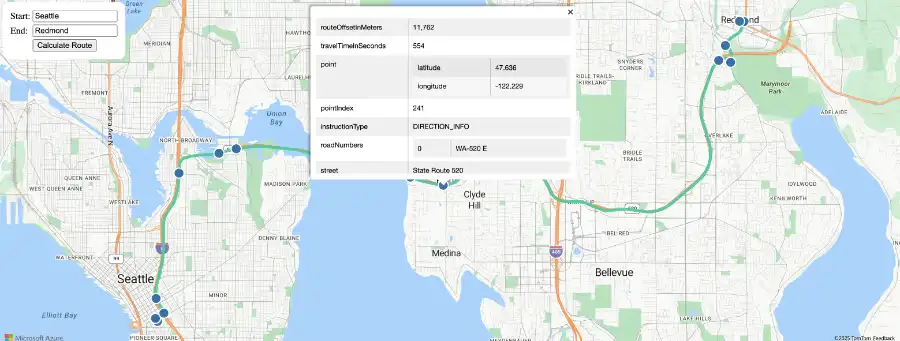Azure Maps offers a reliable suite of weather services. These are a set of REST APIs that, when integrated thoughtfully, can transform how businesses interact with environmental data. There are many weather forecasts available when using Azure Maps’ weather forecast APIs and this article will explore these features, emphasizing their impact on various sectors and the technical considerations for seamless integration.
Azure Maps’ weather services
Azure Maps is a geospatial platform that provides mapping, search, routing, traffic, and time-zone information. In partnership with AccuWeather and other meteorological data providers, Microsoft Azure offers weather data through weather services in Azure Maps, including APIs for weather prediction such as an hourly weather forecast API.
Here are just a few examples of using these weather data services to enhance mapping applications.
Request current weather data
Besides weather forecasts, current conditions can be determined with the current weather API. It provides detailed current weather conditions such as temperature, wind speed, humidity, precipitation, and visibility.
These are retrieved via REST APIs, allowing for integration into mapping applications that demand up-to-the-minute weather insights. This feature is essential for applications that need to display immediate weather information to users.
In addition to using the Azure Maps APIs for live weather updates, you can also retrieve “current” observations from the past 6 or 24 hours for a particular location – as well as climatology data extending back 30 years or more.
Minute-by-minute forecasting
The Get Minute Forecast API call provides hyper-localized weather forecasts updated every minute for up to two hours. The request provides a response to information such as the type of precipitation (including rain, snow, or a mixture of both), start time, and precipitation intensity value (dBZ)
Developers can use this weather forecast API to display precise weather predictions for users in high-impact scenarios, such as outdoor events or emergency responses.
Hourly and daily forecasts
Azure Maps offers hourly weather forecast APIs for up to 24 hours or a daily forecast of up to 10 days. Using the accurate hourly forecast API, users can request detailed forecasts by the hour for the next 1, 12, 24, 72, 120, and 240 hours for a specific location.
Daily weather forecasts for the next 1, 5, 10, 15, 25, or 45 days are also possible using the daily forecast API. The response to the API requests includes comprehensive data on temperature variations, UV index, wind conditions, and precipitation probabilities.
Severe weather alerts
Azure Maps delivers notifications about extreme weather conditions like hurricanes, thunderstorms, tropical storms, or flash floods for a given location.
These alerts, sourced from official Government Meteorological Agencies and leading regional to global to weather alert providers, act as a critical weather API for severe weather alerts to inform users promptly by returning alert types like the category and level of the event.
Weather along a route
Perhaps one of the most distinctive features, this service forecasts weather conditions along a specified route. It’s invaluable for weather APIs for logistics and transportation industries where delays caused by adverse weather can lead to significant losses.

Applications across industries
Many industries rely on weather forecast APIs in their operations. The aerospace industry for instance has aviation-specific weather APIs that ensure the safe and efficient operation of aircraft. While there are many applications of Azure Maps in industry, here are a few ways the forecasts are applied.
- Transportation and logistics: During winter storms, delivery companies can reroute vehicles based on Azure Maps’ weather forecasts to reduce delays. By combining Azure Maps with accurate weather forecast APIs, businesses can refine operational strategies.
- Agriculture: Azure Maps’ localized forecasts enable farmers to mitigate risks and enhance crop yields. Leveraging an API for weather predictions can ensure better planning and management.
- Retail and e-Commerce: By integrating Azure Maps, retailers can employ weather forecast integration to synchronize inventory and marketing strategies with anticipated consumer behavior.
- Energy and Utilities: Weather forecasts help energy companies to predict energy demand, optimize renewable energy usage, and do so much more. For example, solar farms can employ Azure Maps APIs for weather data accuracy to adjust operations based on cloud cover forecasts.
Enhance your application with Azure Maps
Integrating Azure Maps’ weather forecast API data and capabilities into mapping applications provides organizations with a powerful tool to improve decision-making, enhance operational efficiency, and deliver superior user experiences by incorporating advanced weather forecast visualization for user-friendly interfaces that convey data effectively.
By utilizing features of the weather APIs, developers can further customize and expand their applications’ potential. The seamless use of APIs for weather forecasts empowers businesses across industries to optimize their operations and anticipate environmental challenges.
Ready to elevate your mapping solutions? Start building for free with Azure Maps.


